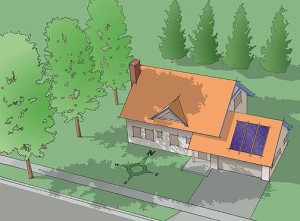When homeowners think about ways to save money on their energy bills, they should consider windows, insulation, light bulbs, and... trees? What you place outside your home can affect your energy usage just as much as what you place inside it, and planting trees and shrubs in strategic locations can yield impressive reductions on your energy usage. Let's look at a few simple landscaping ideas that will cut your energy costs year-round.
Shade Trees:  Landscaping can save you money on your energy bills and make your home more comfortable
Landscaping can save you money on your energy bills and make your home more comfortable
One of the simplest landscaping ideas you can implement is to plant deciduous trees (the kind that lose their leaves in the fall) near to your windows. Sunlight coming in through windows can account for a huge percentage of a home's heat intake; the shade provided by these trees will cut out a significant portion of that heat and make it easier to keep your home cool. Then, in the winter, the leaves will die and fall off, allowing most of the sun's energy to come into your home when you most need it! When planting trees, keep in mind that the sun is more to the north in the summer and south in the winter, so you'll want to leave the south side of your house unobstructed in order to maximize sunlight during the colder months.
Shrubs: Another easy landscaping idea to boost your home's energy efficiency is to plant shrubs around the edge of the building. Adding a line of shrubs around the outside of your home will help trap in warm air, providing additional insulation during colder months. Then, during the summer, the shrubs will keep your house cooler by blocking sunlight that would otherwise hit the house directly and heat it up. The best part about using shrubs is that they will cut your home's energy use as soon as they are planted, so you'll see an immediate return on your investment!
Windbreaks: Wind can strip away the warm air around the house and replace it with cooler outside air that then needs to be reheated at cost to you. Planting a line of trees in the wind's path is a useful way to block much of the wind and keep your heating costs down. First, you need to determine which direction the wind usually blows from. In general the prevailing winds come from the west and north, but it is a good idea to check for your area specifically. Next, select the type of tree you want to use for your windbreak. The same type of deciduous trees that provide shade can be used for windbreaks as well, but evergreens will prove much more effective in the winter months, when the air is coldest and a windbreak most needed. Finally, decide how far out from your house and in what formation you wish to place your windbreak. For the most amount of wind protection the windbreak should be one to three feet away from your house for every foot tall the trees are. So if your trees are 10 feet high you'll want them between 10 and 30 feet from your house. As for formation, a single line of trees works well, but adding additional lines will increase effectiveness and give you greater energy savings. As a bonus, a tight windbreak or hedge blocks the line of sight into your home and provides you with additional privacy!
If you're serious about reducing your home's energy usage through innovative landscaping ideas, follow these links for more details, as well as a handy list of some of the best species of trees to use:
http://www.mortonarb.org/tree-plant-advice/article/703/landscaping-your-home-for-energy-efficiency.html http://www.ext.colostate.edu/pubs/garden/07225.html http://energy.gov/energysaver/articles/tips-landscaping
-Written by John Bramley
Subscribe to NV Roofing's Blog
 Landscaping can save you money on your energy bills and make your home more comfortable
Landscaping can save you money on your energy bills and make your home more comfortable


